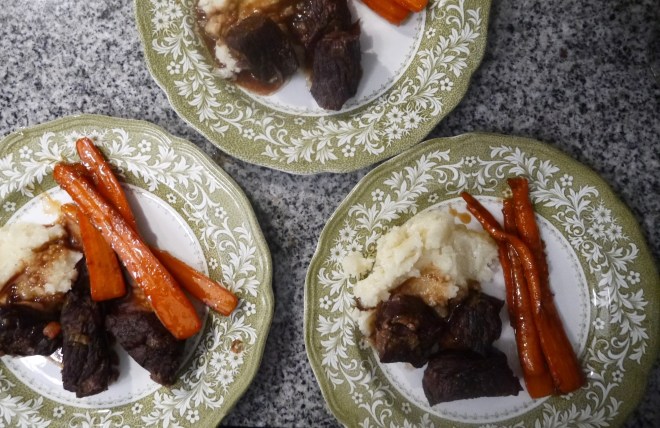
Yum yum! These tender lamb chops are so delicious, plus super quick! They can be grilled or pan-fried, depending on what you have available. I love the combination of garlic, rosemary, dijon, and a bit of vinegar to bring a ton of flavour to these. For this dinner I made some grilled zucchini, and grilled new carrots with a maple glaze. This recipe is one of my own and changes a bit each time I make it; feel free to adapt.
This dish requires little prep, with big results. You just need to prep the mustard sauce before grilling. Plus figure out what else to serve with it. Another nice side dish idea is barbecued skewered baby potatoes, which cook really quickly.
For the lamb I bought a whole rack of lamb and cut it up. This was more cost efficient where I was shopping. You can often by lamb chops pre-cut, so I would plan on two per person, or more if you are feeding big meat eaters.
This recipe is based on 4-6 chops, and the amount of each ingredient can vary depending on your preference. One thing that I think is really important is to use fresh rosemary; the flavour is much brighter than the dried version. If you don’t have fresh rosemary, you probably have a neighbour who does, so you may not have to go buy it.
I like a bit more browning on my meat, therefore I add the mustard sauce after I’ve grilled one side. And alternative is to add a little more vinegar and maybe some olive oil to the mustard sauce, and marinate the lamb in that before grilling. If you try that, please let me know how you liked it!
What you need:
- lamb chops, salted
- 2 teaspoons dijon mustard
- 1 clove of garlic, minced
- 1-2 teaspoons fresh rosemary, minced
- 1-2 teaspoons balsamic vinegar
- freshly ground pepper
- salt to taste
- if you are not grilling you can use 1-2 teaspoons olive oil in a frying pan
What you do:
- Prepare the dijon sauce by combining all the ingredients listed, minus the lamb and cooking oil. I like to do this with a mortar and pestle.
- Prepare your side dishes. The cooking of the lamb will only take a few moments. Heat your bbq or frying pan to medium-high.
- When the bbq or your frying pan is hot, place the chops on the grill/oiled pan. I like mine on the rarer side, so I do about 2 minutes on the first side, making sure I get a good sizzle on them before turning.
- Flip the chops, then top them each with some of the mustard sauce. Cook 2-3 minutes on this side, depending on how well you like them done, and how hot your bbq is.
- Flip them over one more time so that the sauced side gets some heat, then remove to a plate and let them rest a few minutes before serving.
- If I’m frying I like to deglaze the pan with a bit of wine or water, and pour this thick sauce over the chops.
- Enjoy!










